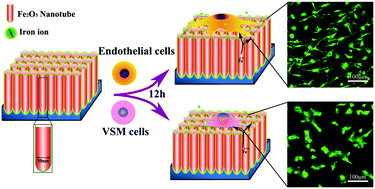Rapamycin-loaded nanoporous α-Fe2O3 as an endothelial favorable and thromboresistant coating for biodegradable drug-eluting Fe stent applications†
Abstract
Iron and its alloys can be potentially employed to fabricate advanced degradable cardiovascular stents due to their excellent mechanical and biocompatibility properties. However, their clinical applications are hindered by their inherent slow degradation rate, the formation of thrombosis and in-stent restenosis. In this study, vertically oriented and orderly arranged α-Fe2O3 (hematite) nanotubes with diameters ranging from 30 nm to 70 nm were successfully fabricated on iron substrates using an anodic oxidation approach. These nanotubular coatings acted as drug depots by being loaded with anti-proliferation drug rapamycin to accelerate the re-endothelialization process and being coated by PLGA through a simple spin-coating process to control the drug release rate. The static immersion test showed that the 50 nm-Fe2O3 nanotube arrays displayed a faster corrosion rate than pristine Fe, and the PLGA coating effectively reduced the initial burst release of the loaded drug and extended the rapamycin release time to 30 days. The CCK-8 assay and immunofluorescence staining analysis results indicated that the endothelial cells (ECs) on the coated samples showed higher cell viability than the vascular smooth muscle cells (VSMCs), with possible outcomes to promote re-endothelialization and decrease VSMC proliferation. In addition, the surface modified iron exhibited very good hemocompatibility. The current findings suggested that fabricating rapamycin-loaded and PLGA coated Fe2O3 nanotubes on a pure iron surface may be a promising method to improve the corrosion rate and accelerate the re-endothelialization of the iron for biodegradable cardiovascular stent applications.



 Please wait while we load your content...
Please wait while we load your content...